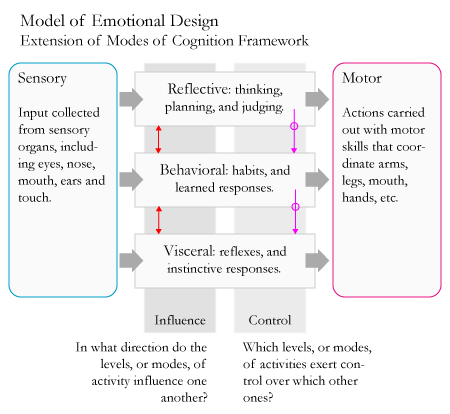In the 90’s Don Norman, along with his colleagues Andrew Ortony and William Revelle, began to explore the role that emotions play in making products easier, more pleasurable, and effective to use. During this time period various design researchers were investigating the link between emotions (especially aesthetics) and usability. These inquiries confirmed that our affective states strongly influence our experiences, and that these states can be induced by design of product systems.
The model they developed aims to explain how different levels of our brain govern our emotions and behaviors. At the visceral level our brain is pre-wired to rapidly respond to events in the physical world by triggering physiological responses in our body. The behavioral level controls our everyday behaviors, including learned routines such as walking and talking. Lastly, the reflective level is responsible for cognitive processes related to contemplation and planning.
Emotions can arise at various levels and are created by a combination of physiological and behavioral responses that are influenced by reflective cognitive processes. An emotion like anger tends to be mostly visceral or behavioral in nature. However, indignation, which is a higher-level version of this emotion, is reflective in nature as well.
The main implication from this model is that our affective states have an impact on how we think. This important insight applies to thinking about the user’s affective state when using the product, and to how a user’s affective state will be impacted by use of the product. In regards to the former consideration, designers can take leverage an understanding regarding common physiological and emotional responses to stressful situations in order to design products that can be successfully used in such contexts.
A users’ experience with a product itself can also have impact on their affective states. High- and low-level emotions can influence all levels of cognitive activity, which is why a one’s visceral response to a product’s aesthetics can impact our behavior. On the other hand, the one’s higher cognitive functions control one’s lower level functions, which is why we can overcome our initial emotional responses if a product is effective enough.
The most common way that designers apply this model is by exploring the design considerations associated to each of the three levels. Visceral design encompasses considerations such as the aesthetics of the look, feel, smell and sound of the product. Behavioral design refers to considerations associated to the product’s usability. Reflective design is concerned with the meaning and value that a product provides within the context of a specific culture.
I consider this model to be an evolution of modes of cognition framework. The main change is that in the Emotional Model the “experiential” mode of cognition has been divided into distinct types of cognition: visceral and behavior. This revision enables the model to reflect the important role played by our emotional response to a product’s aesthetics.
[source: Interaction Design: Beyond Human-Computer Interaction; Don Norman’s book Emotional Design.]
** What the hell is ID FMP? **
Sunday, April 12, 2009
Subscribe to:
Post Comments (Atom)

No comments:
Post a Comment